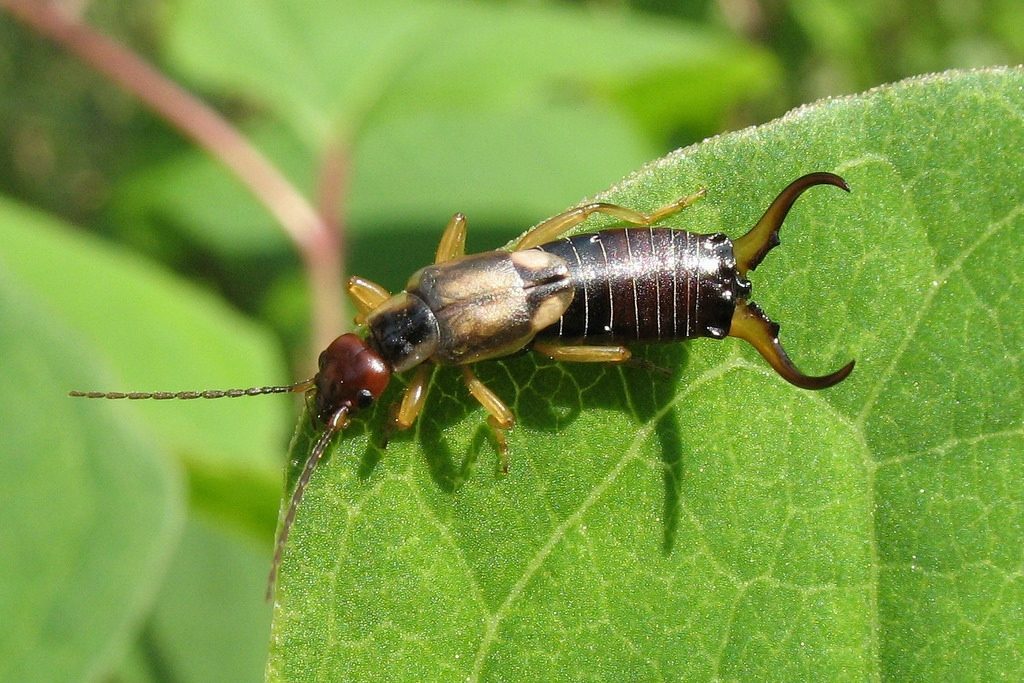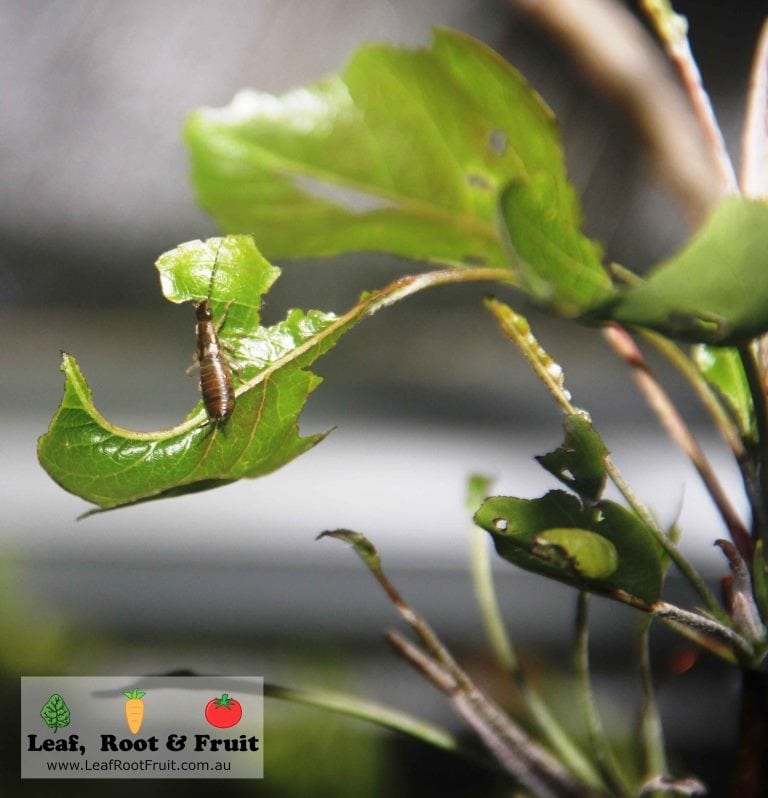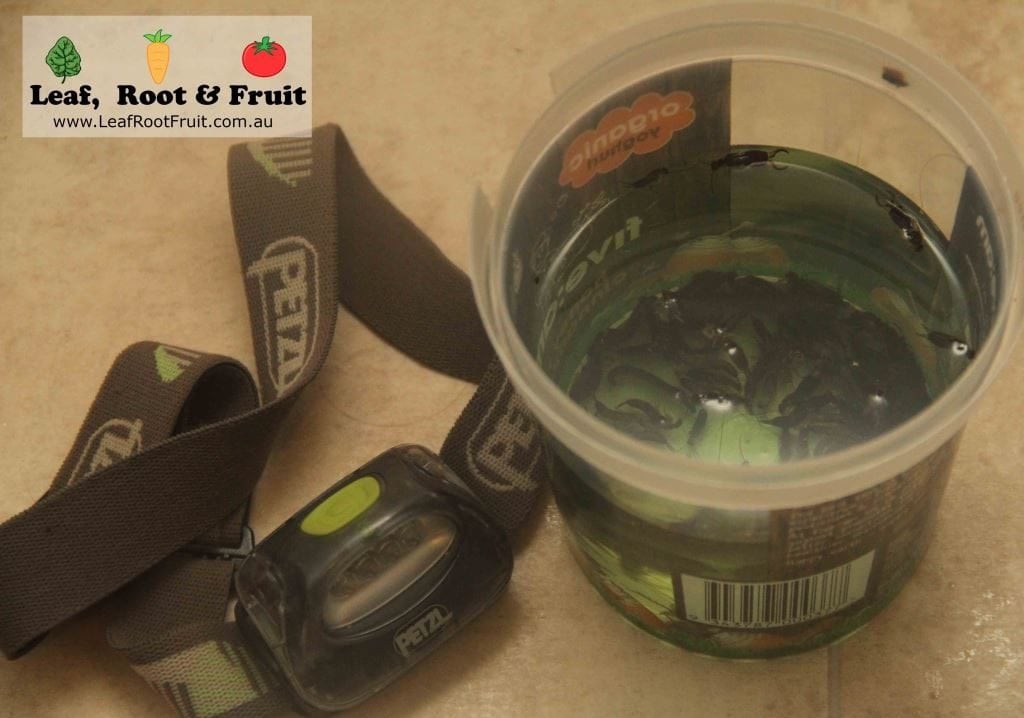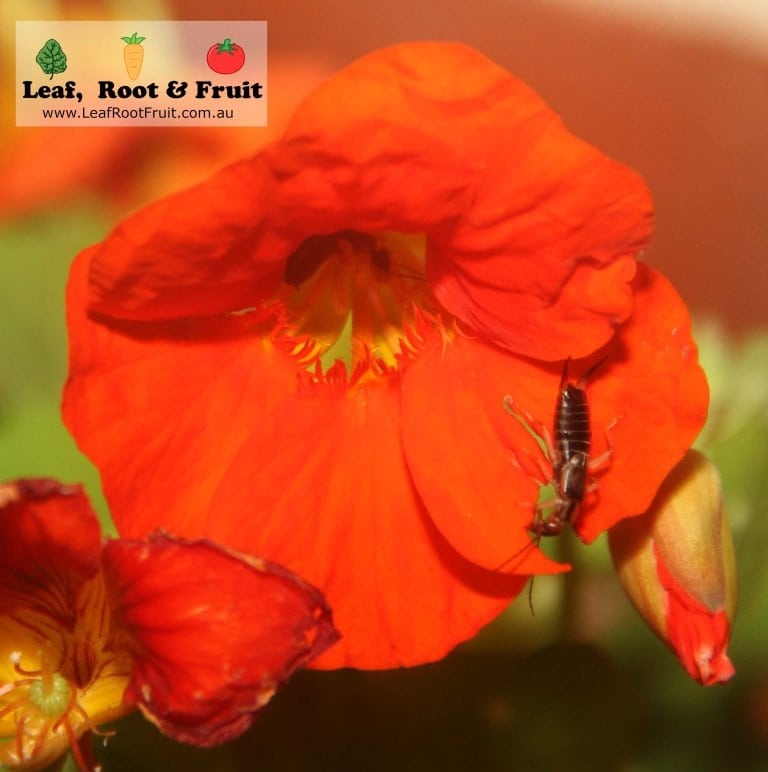
Earwigs are common unwanted visitors to most gardens in Melbourne. They can be quite prevalent in October, which is coincidentally, the time that many of us are looking to plant out our summer vegetables. Earwigs can cause significant damage to young seedlings, but are quite fussy about selecting which ones to attack.
This spring, I am noticing them in large numbers in my garden. They are causing a lot of damage to the tender, young shoots of the deciduous fruit tree foliage as the trees wake up from their dormancy. They seem to have a particular liking for the new growth of my potted pear tree espaliers. Earwigs also seem to prefer:
- Bean seedlings. Often they will eat the new leaves, as they emerge from the ground and only leave the cotyledons on the stalk
- Silverbeet (they often hide during the day down inside the crown of the plant)
- Parsley
- Cucumbers, pumpkins and other Cucurbits
- Kale
- Celery (you’ll often find them hiding between the celery stalks during the day)
They’ll also have a go at tomatoes, Brassicas and other leafy greens, but they don’t seem to cause as much damage to these varieties as the ones above.
Earwigs cause their damage at night time
Earwigs are nocturnal and only come out to feed at night. As such, often they go unnoticed until they have caused a lot of damage. The damage caused by earwigs is different to that of slugs or other leaf chewing pests. Earwigs tend to eat lots of small holes in the leaves of plants. Usually these holes are in the middle of the leaf, rather than around the edge of the leaf. An absence of slime trails is another indicator that earwigs and not slugs are causing the damage. If you’re still not sure, then the best way to diagnose the problem is to try and catch them in the act.

Wait until an hour or two after dark and then grab a torch (a head torch is ideal) and head out into the garden. Check the plants with the most damage for signs of earwigs on them. The earwigs are not too difficult to spot if they are around.
Why not take the kids with you for a bit of fun? If you’re lucky, you might also come across many other nocturnal minibeasts. Last night on my late-night wander through the garden I had an” up close and personal encounter” with a Tawny Frogmouth!
Control methods for earwigs
Once you’ve made sure that earwigs are causing the problem, it’s time to do something about them. I only bother when they are causing significant damage. Once plants get large and established, a few earwig bites aren’t going to be a major issue. However, for small seedlings such as beans – it can cause entire crops to fail before they even had a chance to get growing. Here is a few “earwig control” methods that might work for you.
Soapy water
This is my favourite control method for earwigs. Although it requires you to be quite proactive! You’ll need to don your head torch and go on nightly patrols of the garden. Mix up a strong soapy water solution by adding approximately one part dish-washing liquid to ten parts water. Then you can add this to either a spray bottle or a small bucket or margarine container.

Once you spot an earwig you can either squirt it with the spray bottle (the fun way) or knock the earwig into the container of soapy water (the sensible way). Earwigs breathe through pores in their skin. The soapy water reduces the surface tension and prevents them from breathing. The effect is quite rapid and the earwigs are dispatched quickly.
Keep in mind that all insects breathe this way. So if you use a spray bottle to squirt the earwigs, you may also be killing beneficial insects that get caught up in the spray. That’s why I tend to use a container to knock them into, there’s less collateral damage.
Baited jars
Another method of controlling earwigs is to use baited jars. I’ve heard of people using various soy sauce and oil concoctions. However, the method that I find works well is linseed oil. Simply put a centimetre of linseed oil into an old glass jar or coffee mug and bury it in the soil so that the lip of the vessel is level with the soil. The earwigs will be attracted to the smell of the linseed oil and fall into the jar and drown in the liquid.
This method seems to work really well some nights and catch tens of earwigs per container, then the next night catch nothing, even though there’s still plenty of earwigs around. I’m really not sure why!
Be sure to remove the jar from the garden before it rains, or the jar will fill up and the oil will be the first to spill into the garden. You could try burying the jar on an angle to stop the rain getting in.
Scrunched up newspaper in pots
This is a very old control method for earwigs, although I don’t find it very effective. Simply scrunch up some newspaper and stuff it into an old plant pot. Leave the pots lying around the garden for a few days. The earwigs will take up residence in the pot and then all you have to do is discard the paper in the bin (or shake it out in the chicken run for a protein rich treat).
I’ve heard of people stuffing the newspaper into terracotta pots and then burning the paper every few days. Although I’m not sure how effective this would be.
Sacrificial crops
Why not try a few sacrificial crops? I’ve noticed that earwigs really love nasturtium flowers (they don’t seem to touch any other part of the plant). So plan ahead and have some nasturtiums covered in flowers for next spring. The earwigs will be attracted to the flowers and hopefully, not so much to your seedlings. At the very least, it makes it fairly easy to go hunting for them and reduce their numbers when the time comes. Nasturtiums are also a great sacrificial crop for white cabbage butterfly. Possums don’t seem to like them so you can use them to hide young seedlings among their growth until they get established. They’re also edible and make a great ground cover, so there are many reasons to plant some in your garden.

Do you have a tried and tested method for the control of earwigs in your garden? If so please let me know in the comments section below so that I can incorporate them into this post.
Want to know more about garden pests?
The idea of a relaxed approach to pest control will appeal to many of you. I have put together a three part blog post series on pests, predators and effective control methods.
If you would like further information on garden pests, then part 26 of the Vegetable Patch from Scratch is a good place to start.


Earwigs love dried cat food. Put it around your plants and they will eat it instead of your plants.
Sounds like a great tip. Thanks for sharing Steve.
Good Luck and Happy Gardening!
Thanks for tthe oil and soy sauce advice. It worked last night. To protect my newly planted bean plants, I plant the seed in the ground with a plastic open ended cylinder around it firmly pushed into the soil. It is cut from a clear plastic 1 litre water bottle, two from each bottle, or a 1 litre milk bottle. Plastic can be easily removed when beans are approximately 10cm high and able to cope with predators such as earwigs.
Hi Rachel,
Thanks for sharing your experience and some great tips on re-using resources in the garden.
Glad to hear you’ve limited the damage caused by the earwigs.
Good Luck and Happy Gardening!
Duncan
RE the method of crumpled paper in pots to trap earwigs, they produce an aggregation factor which attracts them to the paper. It may take a while for this to be effective, but if it is, don’t discard the paper, reuse it and it will attract the next lot. I also find lots of earwigs in cloth bands I wrap around fruit trees to trap downward heading codling moth larvae, so I take a bucket and let them fall in to a mix of pyrethrum and eucalyptus oil diluted in water. I will try the soapy water trick though.
Thanks for sharing your wisdom! Some great advice there.
I enjoy your writing style, it’s easy to read links further info. I realise that that is the purpose of a web site but you have not forgotten that some of us are learning how to grow with our fruit verges and flowers. I appreciate you
Hi Dawn,
Thanks for the great feedback. It makes the effort to keep the website running all worth it!
Stay Safe & Keep Gardening!
I have just discovered earwigs may be the problem I have been blaming solely on the snails and slugs…….although I’m sure it’s a collaborative effort!! Thanks so much for this valuable information. Much appreciated.
Glad you found our blog post useful Julie!
Thanks, am going to try the linseed oil as I have plenty of earwigs in my garden. Your blog is very interesting, look forward to seeing more.
Jackie
Glad you found it useful Jackie. Good luck & happy gardening
Would earwigs have caused the dimpling and skin deformation in the nectarines on my established necatrine tree? first time i’ve seen this on what is usually a bumper crop of happy nectarines.
We’re in Castlemaine.
Thanks!
Hi Kristin,
Yes it could be earwigs. This can also be caused by bad infestation of curly leaf. Usually this disease only affects the leaves, but it can affect the skin of some nectarine varieties. It was a bad season for curly leaf this year, so that I think is the likely cause.
Good Luck & Happy Gardening
I put out a trap of beer thinking slugs were causing damage to my seedlings – came out to discover a container full of earwigs the next day. Big fan of this method as catches slugs and earwigs! Also the beer doesn’t hurt the garden is it rains I don’t think.
Hi Caitlin,
That’s a great result! I’ve also found that beer is good bait for catching slaters.
Happy gardening
Duncan
I just crumpled up sheets of newspaper and placed around plants in the evening (no need for putting newspaper into pots) then in the cool of the early morning I lift the newspaper sheets where they hide and shake or flick then into a bucket of soapy water. Works extremely well – also gives you an idea of the ‘headcount’ where the biggest infestation occurs. Need to repeat for a few days.
Thanks for the great tip Allie.
Happy gardening.